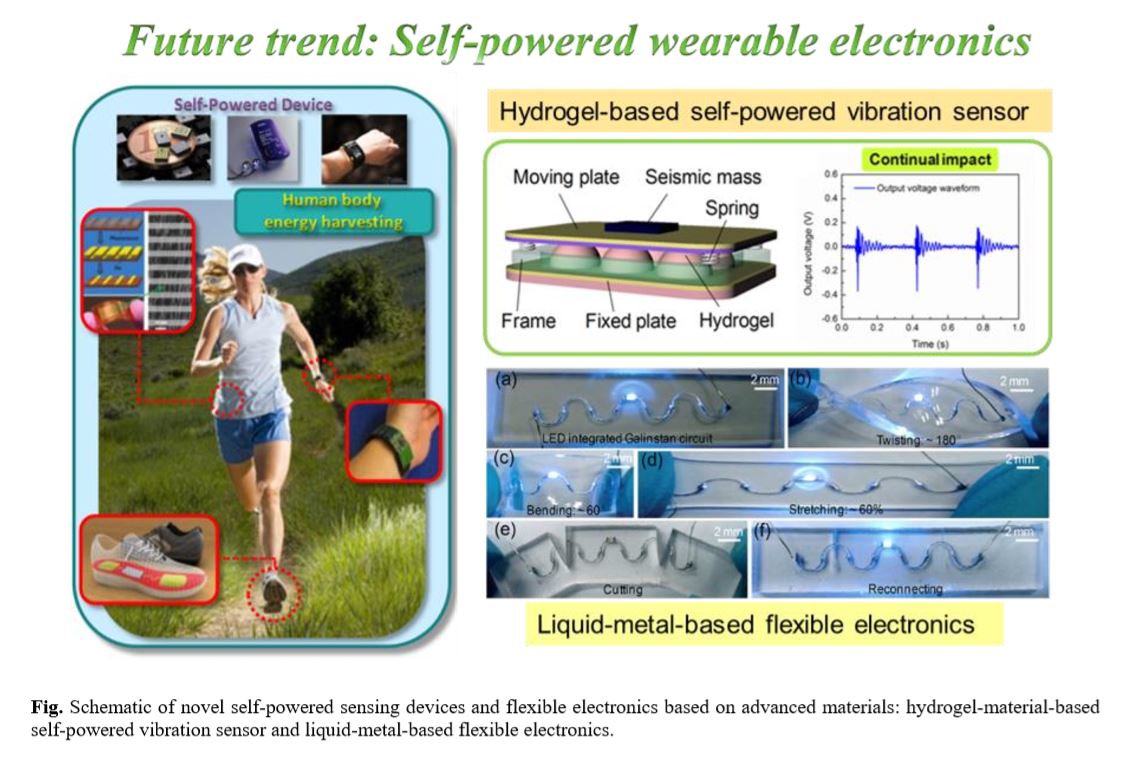Video Article Open Access
Novel Self-powered Sensing Devices and Flexible Electronics based on Advanced Materials
Xuan Wu
School of Mechanical Engineering, Jiangsu University, Zhenjiang, 212013, China
Vid. Proc. Adv. Mater., Volume 2, Article ID 2021-0153 (2021)
DOI: 10.5185/vpoam.2021.0153
Publication Date (Web): 20 Jan 2021
Copyright © IAAM
Graphical Abstract

Abstract
Since the 21st century, the new generation of intelligent information technology has developed rapidly, such as self-powered devices and flexible electronics [1]. Meanwhile, the emergence of various new advanced materials brings new development opportunities to the research of self-powered sensing technology and flexible electronic devices. In this lecture, two researches based on advanced materials will be introduced: (1) Self-powered sensing device based on biocompatible hydrogel material. Hydrogel is a network of polymer chains with superabsorbent capability to water molecules, sometimes found as a colloidal gel in which water is the dispersion medium. Due to their hydrated environment and various advantageous properties (e.g., mechanical and chemical properties, flexibility, charging ability, and biocompatibility), hydrogels have found widespread applications in biomedical engineering [2]. In this research, a novel hydrogel-based energy conversion method for scavenging environmental vibration energy is proposed and experimentally verified. In this approach, hemispherical hydrogel arrays are positioned between two parallel-arranged conductive plates. The deformation of hydrogel arrays caused by ambient vibrations will result in non-equilibrium charge distribution in the conductive plates. The charge redistribution leads to electrons transfer, thereby converting mechanical vibration energy into electricity. Based on this energy conversion principle, a hydrogel-based self-powered vibration sensor is realized and demonstrated. A broad bandwidth of 0–80 Hz is achieved in the performance test, which covers most frequency ranges of daily vibrations. In addition, a visualized self-powered force sensor are also developed and demonstrated, which reveals its potential in diverse application fields of self-powered intuitive sensing like artificial skin. (2) Flexible electronic device based on liquid metal. As the rapid development of science and the improvement of people's health awareness recently, the demand for flexible electronics is increasing, such as wearable electronics, flexible display, etc. However, traditional metal-wire-based circuit cannot tolerate the stretching and bending of the flexible electronic device, which leads to the disconnection of the circuit. Galinstan is a non-toxic liquid metal alloy with the composition Ga–In–Sn (68.5%, 21.5% and 10% by weight, respectively) [3]. It exhibits fluidic performance at room temperature. Galinstan has excellent physical properties like low melting point, low electrical resistivity, high boiling point, high thermal conductivity, and ultralow vapor pressure. In this research, an innovative and versatile selective liquid-metal plating (SLMP) process to realize a transparent stretchable circuit board (TSCB) with the capability of large deformation and self-healing is presented. The TSCB integrated with a light-emitting diode exhibit stable performance, even though it is twisted more than 180◦ or is stretched up to ∼60% 6000 times. To evaluate the feasibility of the SLMP process, an electrical filter was fabricated on the PDMS substrate and the current–voltage (I–V) characteristics are successfully demonstrated under various conditions. The experimental results reveal that the proposed idea has the potential to enable flexible electronics such as wearable devices, flexible displays, and other stretchable electronics.
Acknowledgement
This work was supported by the Senior Talent Foundation of Jiangsu University (No.18JDG010) and the National Science Foundation of China (No.51479082). This research was also supported by the National Research Foundation of Korea (NRF) grant funded by the Korean government (No.2015R1A4A1041746).
References
- Z. Wen, M. H. Yeh, H. Guo, et al., Science advances, 2016, 2(10), e1600097.
- Y. Li, G. Huang, X. Zhang, B. Li, Y. Chen, T. Lu, et al., Advanced Functional Materials, 2013, 23, 660.
- I. D. Joshipura, H. R. Ayers, C. Majidi and M. D. Dickey, Journal of Materials Chemistry C, 2015, 3, 3834.
Biography
Xuan Wu is a Professor of Mechanical Engineering at Jiangsu University, China. He received the Ph.D. degree in Mechanical Engineering from Chonnam National University, South Korea. His research interests include self-powered sensing systems, energy harvesting technology, flexible electronics, MEMS and nanotechnology. In recent years, he published more than 30 scientific papers on reputable journals and international conferences, such as “Applied Energy”, “IEEE-ASME Transactions on Mechatronics”, “International Journal of Energy Research” (Cover paper), “Lab on a Chip” (Cover paper), “Sensors and Actuators B: Chemical”, “Transducers 2015”, etc. His research was rewarded as “Best Paper Awards” in “The 5th Japan-China-Korea MEMS/NEMS International Conference” and “Best Paper Awards” in “2013 Kroean Society for Precision Engineering Conference”, respectively. He also got the “Best Research Award” from Korean National Key Laboratory. In 2018, Professor Xuan Wu was awarded “IAAM scientist Medal” by International Association of Advanced Materials. He was also selected as “Representative Scientist of Scientific and Technological Pioneers” by the Journal of “Management and Research on Scientific & Technological Achievements”.
Video Proceedings of Advanced Materials

Upcoming Congress



